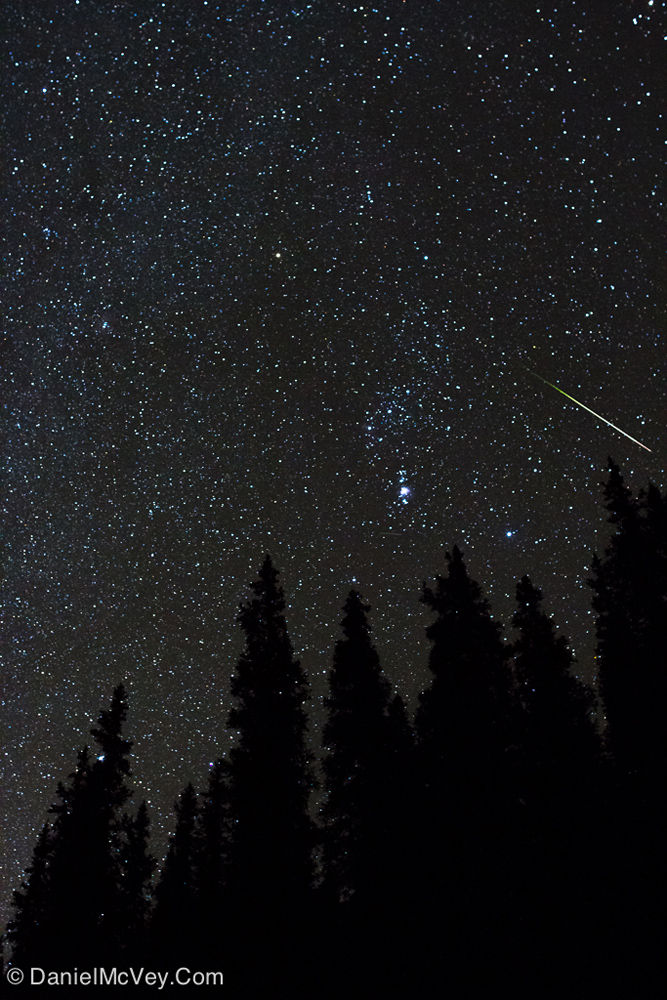Orionid Meteor Shower Peaking Now: See Shards of Halley's Comet Online

Editor's Note: The first photos and video of the 2013 Orionid meteor shower are in. See our latest story on the meteor display here: Orionid Meteor Shower Sparks Bright Fireballs - Video
The leaves are turning, there's a nip in the air and the Orionid meteor shower spawned by Halley's Comet is at its peak overnight tonight (Oct. 20).
If the bright moon or bad weather doesn't spoil the view, stargazers can catch a glimpse of the annual Orionid meteor shower as it reaches its peak late Sunday and early Monday (Oct. 21). The Orionids, so-named because they appear to spring from a region to the north of the constellation Orion's second brightest star, Betelgeuse, are a less impressive version of the Perseid meteor shower that occurs in August.
The online Slooh Space Camera will air a live 15-minute broadcast of the meteors from the Canary Islands off the coast of West Africa at 8 p.m. EDT (0000 GMT/5 p.m. PDT) today. You can watch the Orionid meteor shower webcast live here, courtesy of Slooh officials. [Photos: Orionid Meteor Shower of 2012]
Unfortunately for casual observers, the bright moon - which reached its full phase on Friday (Oct. 18) - may wash out most of the view. Weather permitting, viewers can expect to see at most one shooting star every three minutes. That's about a third as many as are visible in the Perseids or December's spectacular Geminids.
"Moonlit skies from a bright waning gibbous moon make this a less than favorable year for viewing," a NASA meteor shower guide for 2013 explains. "However, the Orionids are known for being bright meteors, so there still might be a good show in the early hours before dawn."
During tonight's Slooh webcast, viewers can tweet their questions using the hashtag #Orionid. You can also watch the supernova webcast live on the online Slooh Space Camera website and the Slooh iPad App.
Breaking space news, the latest updates on rocket launches, skywatching events and more!
The shower will be most visible in the hours around 5 a.m. EDT (0900 GMT), when Orion is highest in the southern sky. The Orionids are dim, so astronomers recommend watching far from urban areas. The meteor shower is visible in both the Northern and Southern Hemispheres.
The Orionids usually start to appear around Oct. 17 at a rate of about five per hour. The shower reaches a maximum Oct. 19 through Oct. 23, generally peaking the morning of Oct. 21. By Oct. 25, activity has subsided to five meteors per hour.
Comets are basically balls of dusty ice, so as the sun melts the ice, the comet trails dust and debris behind, which the Earth passes through twice a year during the Eta Aquarid meteor shower in May and the Orionids in October.
Editor's note: If you snap an amazing picture of the Orionid meteor shower or any other night sky view that you'd like to share for a possible story or image gallery, send photos, comments and your name and location to managing editor Tariq Malik at spacephotos@space.com.
Follow Tanya Lewis on Twitter and Google+. Follow us @Spacedotcom, Facebook and Google+. Original article on SPACE.com.

![Learn why famous meteor showers like the Perseids and Leonids occur every year [See the Full Infographic Here].](https://cdn.mos.cms.futurecdn.net/VDWEKQFLr8yuXkTL4YkHqj.jpg)

